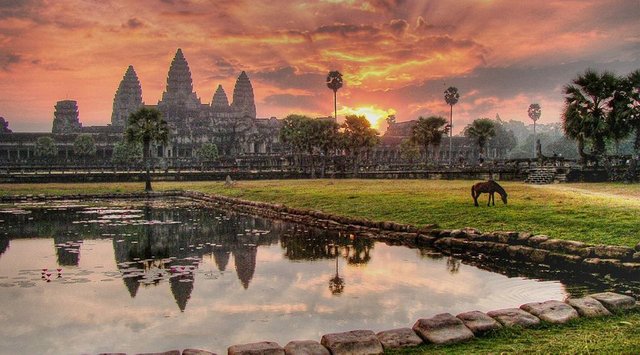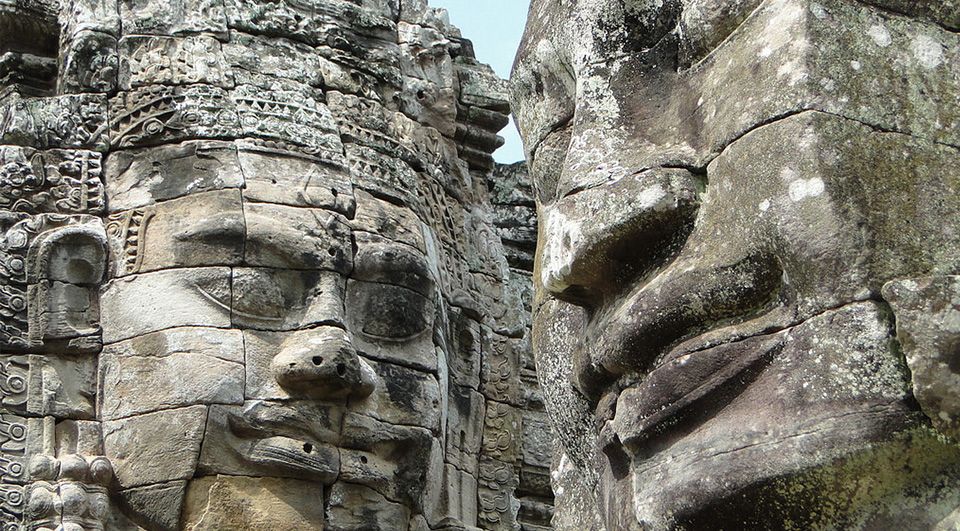Cambodia: Kingdom of Wonder

The Kingdom of Cambodia has seen some turbulent times in the latter half of the 20th century but now, once again it is at peace and is set to take its place as one of South East Asia’s most fascinating and rewarding destinations.
Cambodia lies in the heart of South-East Asia bordering Vietnam to the east, Laos to the north and Thailand in the west. Despite being much smaller than its neighbors Cambodia’s unique Indian-influenced Khmer culture has remained very much intact. The once mighty Khmer Empire flourished during the Angkorian period between the 9th and 14th centuries when it was the cultural centre of the region and exerted its influence over Vietnam, Laos and Thailand. For
many of today’s travellers the incredible architectural legacy left from this period of history, the temples of Angkor are without doubt the main reason for visiting Cambodia. The base for exploring the temples of Angkor is the provincial capital, Siem Reap.

The modern day capital of Cambodia is Phnom Penh, once considered one of the most beautiful cities of the Orient; it still retains much of its original charm with the exotic roof lines of Khmer temples contrasting with some classic European architecture from the French colonial years. Sihanoukville, also known as Kompong Som, is a beach resort on the Gulf of Thailand that is now beginning to attract visitors in increasing numbers.
Nobody leaves Cambodia disappointed. The exotic land of the Angkor Kings lies waiting to be explored.



Location and Geography
Cambodia is located in Southeast Asia, on the Indochinese peninsula. It is bordered in the north-west by Thailand, in the southeast by Vietnam and in the north by Laos. The coastline of about 450 km in the south borders the gulf of Thailand. The terrain is mostly low and flat plains with mountains in the southwest and north, partly being natural borders to Thailand and Laos.
With a total landmass of about 180,000 square kilometers Cambodia’s size can be compared to the size of Switzerland being one of the smaller countries in Southeast Asia with a population of around 14 million. The Mekong River, one of the largest rivers in the world is flowing all the way from the Himalaya through Cambodia and Vietnam into the South Chinese Sea.
Lake Tonle Sap located almost in the middle of the country is the largest freshwater floodplain lake in the world, increasing and decreasing in size annually from 3000 square km in the dry season to 12,000 square km in the wet season, creating a very productive environment for both wildlife and people.
Khmer History
There are barely nations to find in the world which are so closely connected to their history as the Khmer. Despite their sad and destructive history of war and terror regimes the Khmer haven’t lost their self confidence regarding themselves as the descendants of the artificers of Angkor.
From the high ruling royal culture of the Angkorian times to the riots and wars with Vietnam, Thailand and the US, Cambodia has gone through a lot of different phases in their history.
The bloom of Cambodia, the time of Angkor from the late 9th century until the middle of the 15th century, with its amazing temples and cities like Angkor Thom, a royal metropolis with more than a million inhabitants, Cambodia used to be one of the early high powers in Southeast Asia, a proud and free country.
Successful and capable emperors were ruling over metropolis with more than a million inhabitants, unique dimensions all over the world for the ancient era. Not to mention Angkor Wat a stunning temple and tomb for king Suryavarman II, builder of many of the ancient temples and masterpieces of that time, which are even today popular all over the world.
After the fall of the Angkorian empire Cambodia has always been endangered to be conquered and taken over by either Vietnam or Thailand. Due to this one could almost speak of a historical period regarding the still continuing tensions between these countries.
If the French hadn’t declared Cambodia their protectorate in 1863 surely Cambodia would be split among Thailand and Vietnam nowadays.
The almost 100 years of French reign over Cambodia helped the country to gain peace and blossom out again. Not only typical art-deco houses and villas were built, but also a complete railroad network throughout Cambodia linking the east to the west and the north to the south.
Sihanoukville at the coastline was discovered to become “the Riviera of the east” being a sophisticated retreat for the French and rich Khmer. The capital of Phnom Penh developed and became one the most ambitious metropolis in Southeast Asia.
Followed by the upcoming communism in the 1950’s in Vietnam, Laos and Cambodia sadly the country opened another dark chapter of history. However, communism wasn’t actually following the ideas of Marx’s or Lenin but can be regarded as nationalism against the colonial powers to loosen the chains.
Cambodia now even went through more problems and queries with their neighboring countries and the ruling of the Khmer Rouge.
Hopefully the Khmer Rouge, led by Pol Pot, which tried to wipe out the knowledge and the elite of the country by killing more than 2,000,000 innocents, was the last chapter hindering the proud nation of the Khmer to fully develop and regain the benefits of the past to be led into a new and bride future.
Art and Culture from Cambodia
Several generations share the same roof, the same rice and the same religion as life in Cambodia is mainly centered on family, food and faith.
Belonging to a family is more than we know in the western world; everyone from 3rd cousins to obscure aunts, as long as there is a bloodline there is a bond.
In Cambodia the people are very friendly and welcoming.
Religion is another very important column in the life of the Cambodians. Almost every house would have its own little shrine and everyone is very spiritual and praying not only at the shrines but also the temples and pagodas.
Therefore, the monks collecting donations in the street from the people – bowing in order to show their respect to the monks – is a very common picture all over the country.
Religion and Beliefs
To understand Cambodia one has to understand its religion.
Ninety five percent of the very religious and traditional population belongs to the Buddhism, affecting everyday life. Buddhist monks belong to the landscape in the big cities like Phnom Penh as much as they do to the countryside where they often fulfill the extra duty of being teacher and doctor besides being the spiritual guide.
In the mornings it is a common procedure that the monks will go from house to house to collect offers for the temples in order for the population to find spiritual healing.
The two main religious streams of Buddhism (Theravada & Mahayana) are both established in Cambodia where as the more popular Theravada-Buddhism is mainly spread among the Khmer.
Former practiced forms like natural religions and Brahmanism are still an important element of today’s beliefs of the Khmer. Deeply rooted ancestor worship and the belief in spirits are relics from the turn of the millennium more than a thousand years ago.
Also the Devaraya cult, belief in the god king, gives the king of Cambodia even today especially spiritual power and status.
Hi! I am a robot. I just upvoted you! I found similar content that readers might be interested in:
http://www.globaltravel-cambodia.com/cambodia.php
Congratulations @khemarak! You have completed some achievement on Steemit and have been rewarded with new badge(s) :
Click on any badge to view your own Board of Honor on SteemitBoard.
For more information about SteemitBoard, click here
If you no longer want to receive notifications, reply to this comment with the word
STOP